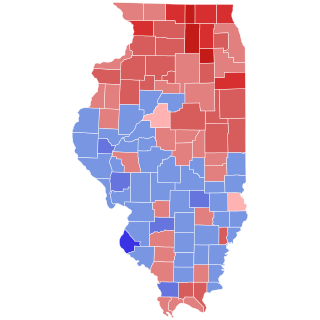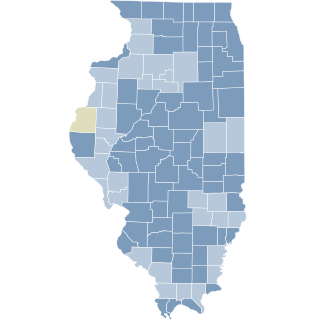
The governor of Illinois is the head of government of Illinois, and the various agencies and departments over which the officer has jurisdiction, as prescribed in the state constitution. It is a directly elected position, votes being cast by popular suffrage of residents of the state. The governor is responsible for endorsing or vetoing laws passed by the Illinois General Assembly. The office also carries the power of pardon and commutation under state law. The governor is commander-in-chief of the state's land, air and sea forces when they are in state service. Illinois is one of 13 states that does not place a term limit for governor.

The Illinois General Assembly is the legislature of the U.S. state of Illinois. It has two chambers, the Illinois House of Representatives and the Illinois Senate. The General Assembly was created by the first state constitution adopted in 1818. As of 2025, the current General Assembly is the 104th; the term of an assembly lasts two years.

The lieutenant governor of Illinois is the second highest executive of the State of Illinois. In Illinois, the lieutenant governor and governor run on a joint ticket and are directly elected by popular vote. Gubernatorial candidates select their running mates when filing for office and appear on the primary election ballot together. When the governor of Illinois becomes unable to discharge the duties of that office, the lieutenant governor becomes acting governor. If the governor dies, resigns or is removed from office, the lieutenant governor becomes governor. Under the Illinois Constitution, the Attorney General is next in line of succession to the Governor's office after the lieutenant governor, but does not succeed to the lieutenant governor's office. From the impeachment of Rod Blagojevich in 2009, until the inauguration of Sheila Simon in 2011, Attorney General Lisa Madigan would have become governor if Pat Quinn had vacated the office. Historically, the lieutenant governor has been from either the Democratic Party or Republican Party. The current lieutenant governor is Democrat Juliana Stratton.

The 2006 Illinois elections were held on November 7, 2006. On that date, registered voters in the State of Illinois elected officeholders for U.S. Congress, to six statewide offices, as well as to the Illinois Senate and Illinois House.
Illinois is considered a blue state, one of the three largest states that consistently supports Democratic Party federal candidates alongside California and New York. Following the 2018 elections, all six statewide elected offices are held by a Democrat. There is a significant division between Democratic-leaning cities and college towns, and highly conservative rural regions, which continue to be dominated by Republicans, but are drowned out due to their relatively low population.

Elections were held in Illinois on Tuesday, November 2, 2010. Primary elections were held on February 2, 2010.

The 1848 Illinois gubernatorial election was the ninth election for this office. Democratic governor Augustus C. French was easily re-elected. This was the first gubernatorial election in Illinois that was held on the same date as the United States presidential election.

The 1864 Illinois gubernatorial election was the thirteenth election for this office and took place during the American Civil War. Republican governor Richard Yates did not run for re-election, but was instead elected to serve in the United States Senate. Major General Richard J. Oglesby resigned his commission to run as the Republican nominee. Congressman James Carroll Robinson was the Democratic nominee. At this time in Illinois history, the Lieutenant Governor was elected on a separate ballot from the governor. This would remain the case until the adoption of the 1970 constitution.

The 1872 Illinois gubernatorial election was the fifteenth election for this office. Republican nominee, Former Governor Richard J. Oglesby defeated the Democratic and Liberal Republican nominee Gustavus Koerner. B. G. Wright represented Independent Democrats unwilling to ally with Liberal Republicans. Oglesby had agreed to run for the Governorship but to resign upon being elected so that Lt. Governor John Lourie Beveridge could assume the office. Oglesby was in turn appointed to the U.S. Senate.

The 1972 Illinois gubernatorial election was held in Illinois on November 7, 1972. Incumbent first-term Republican governor Richard B. Ogilvie lost reelection in an upset to the Democratic nominee, Dan Walker.

Two United States Senate elections were held in Illinois on March 26, 1913. The two elections were interconnected through a compromise made to elect a Democrat in the regular election and a Republican in the special election.

Elections were held in Illinois on Tuesday, November 7, 1978.

Elections were held in Illinois on Tuesday, November 5, 1968.

Elections were held in Illinois on Tuesday, November 4, 1952.

The 1952 Illinois gubernatorial election was held on November 4, 1952.

Elections were held in Illinois on Tuesday, November 5, 1940.

On November 2, 2010, Illinois voters approved the Illinois Governor Recall Amendment, a legislatively referred constitutional amendment to the Constitution of Illinois. The amendment changed the state constitution to allow recall elections of Illinois governors.

The 1876 Illinois gubernatorial election was the sixteenth election for this office. Representative Shelby Moore Cullom narrowly defeated businessman Lewis Steward for the Governorship of Illinois. This was the narrowest victory for a Republican Governor since 1856, when William H. Bissell narrowly won the office in a plurality. Cullom's victory was the sixth consecutive victory for the Republican Party. Cullom also slightly overperformed Republican candidate Rutherford B. Hayes in the concurrent Presidential election.

The 1884 Illinois gubernatorial election was held on November 4, 1884.












